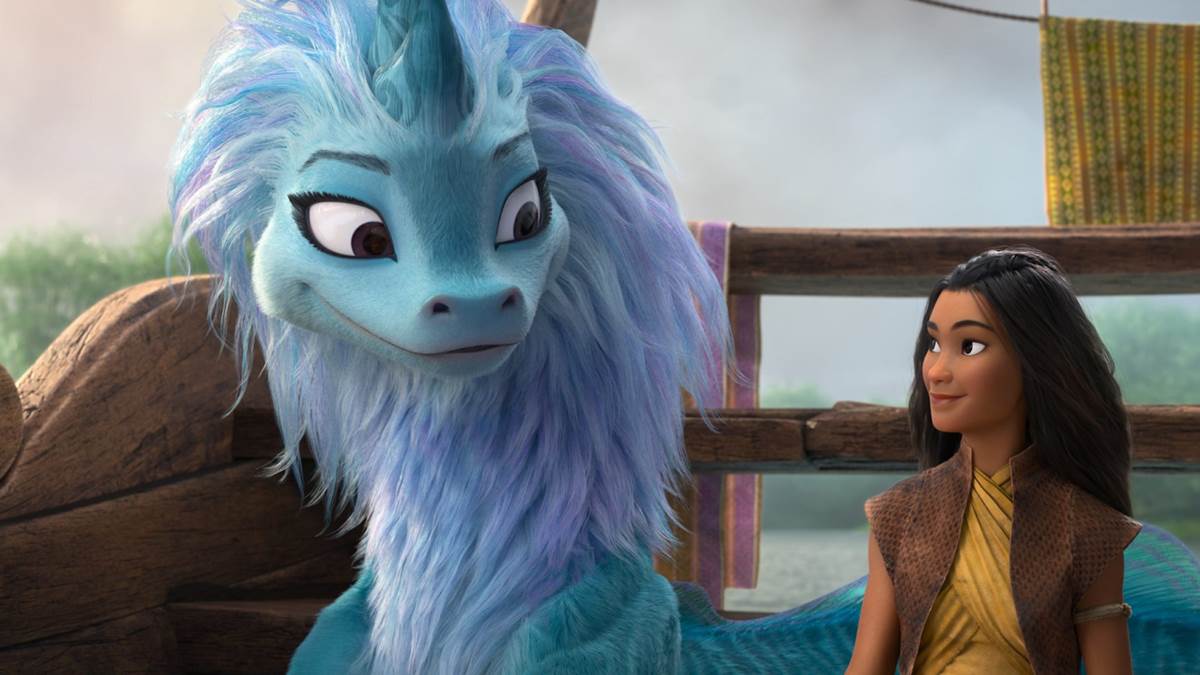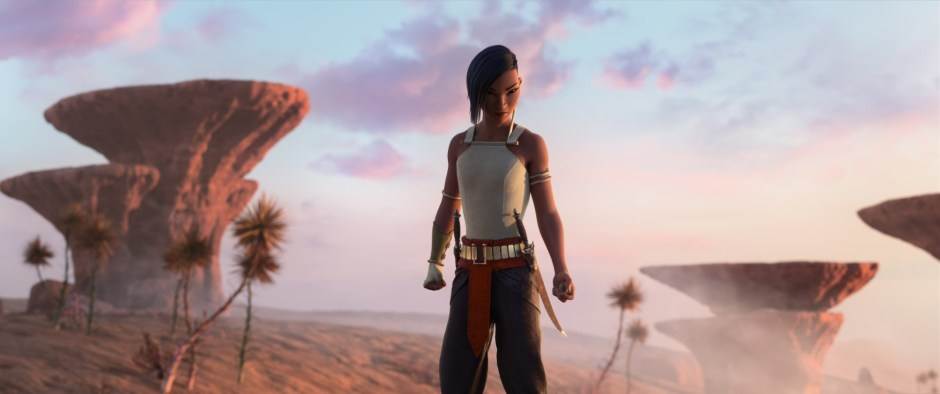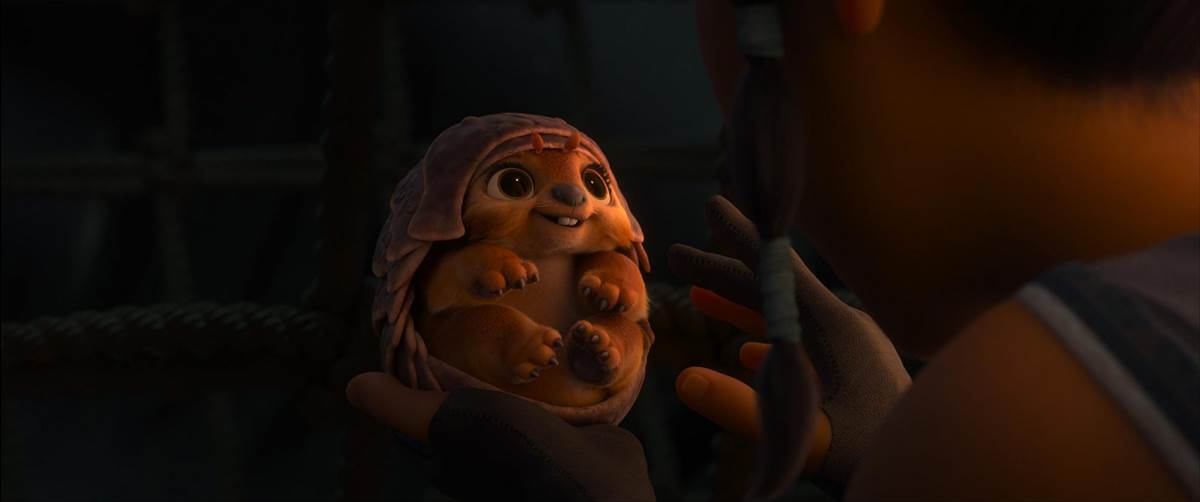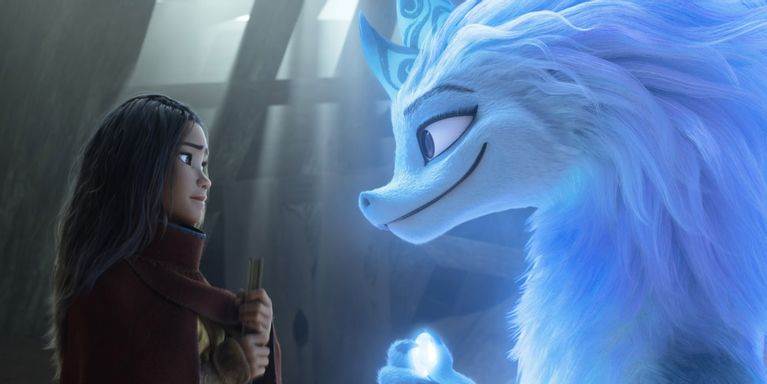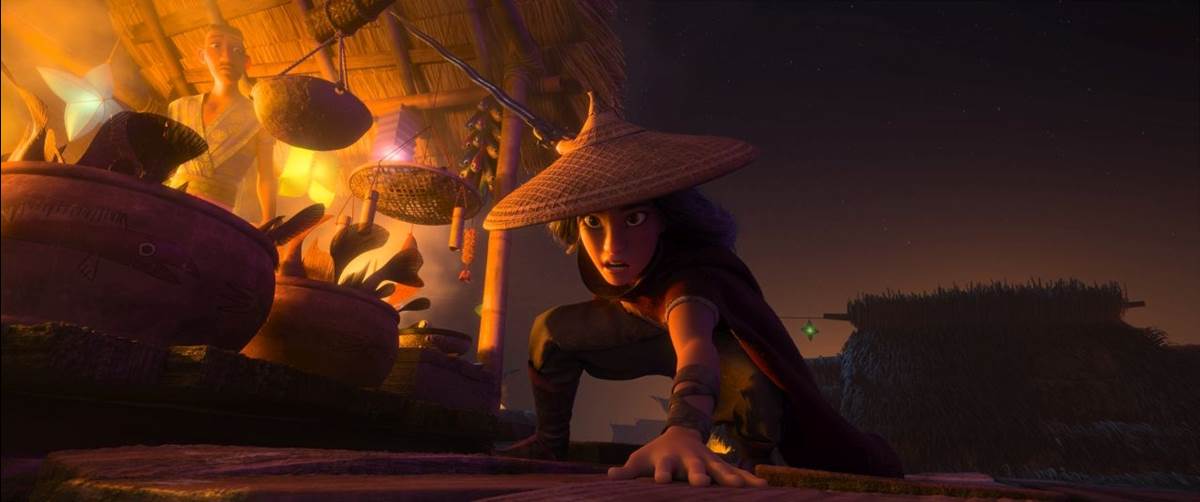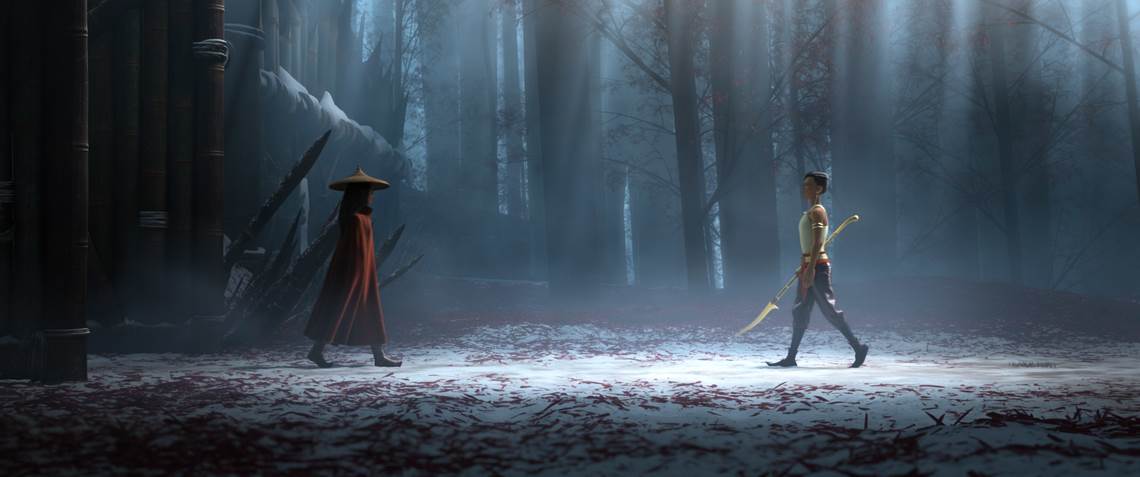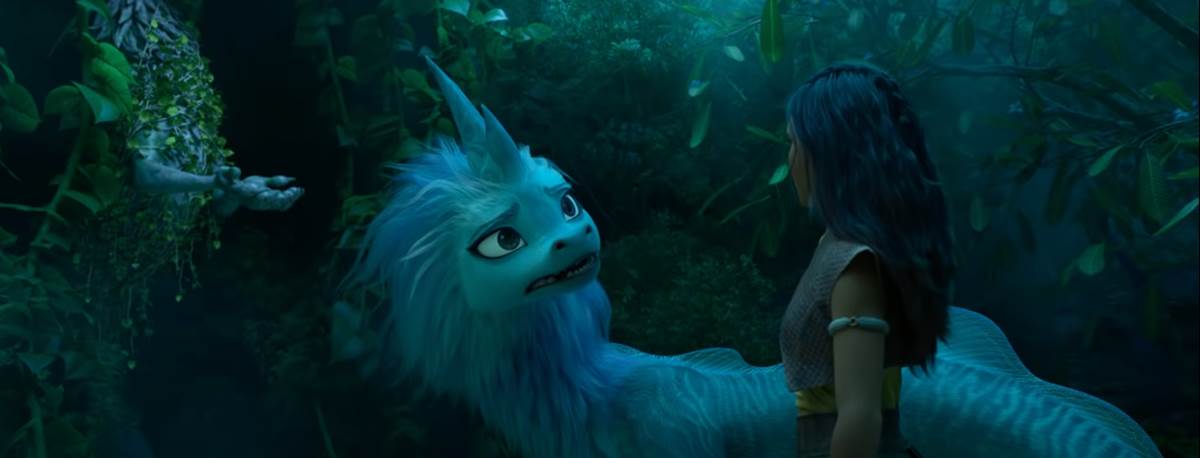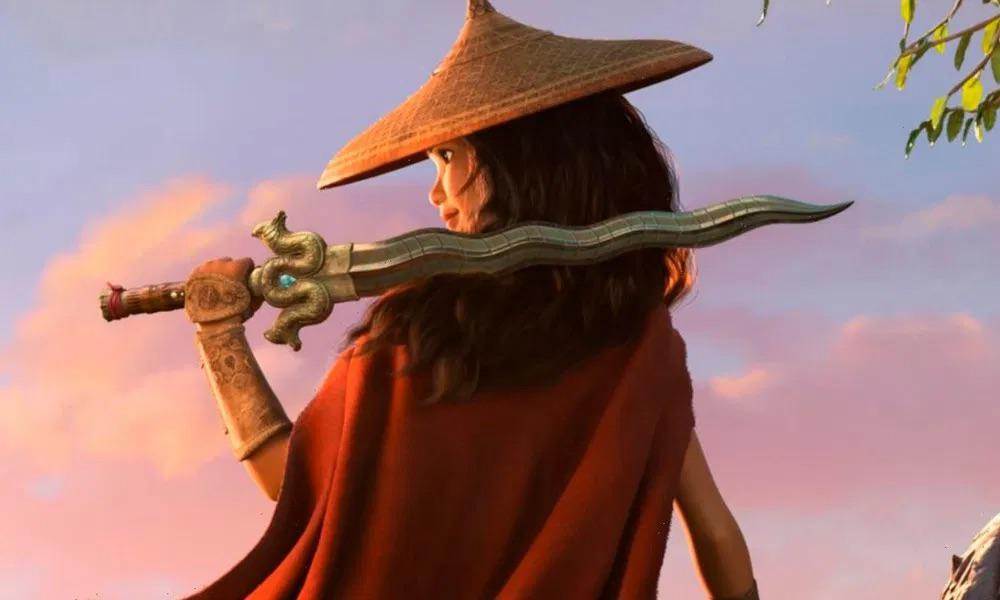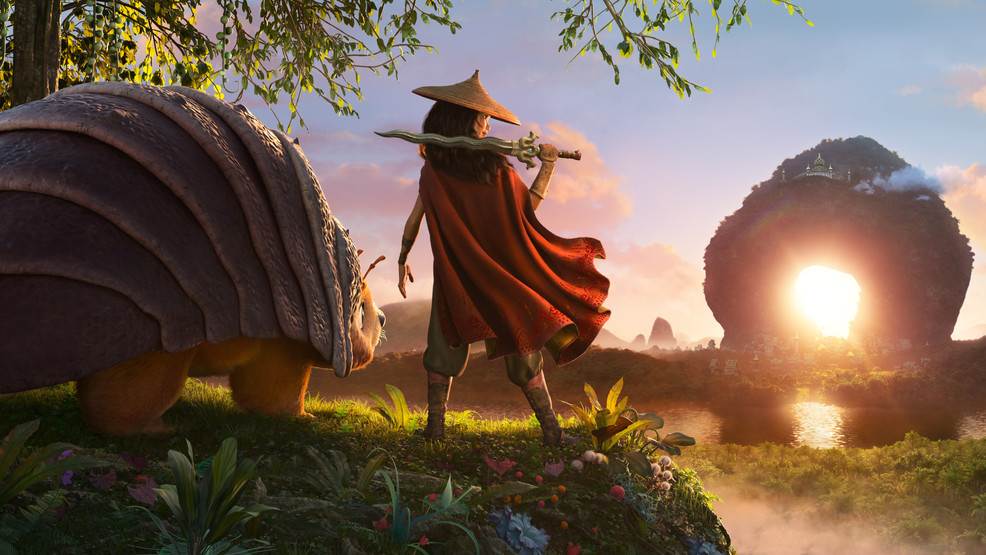To celebrate the upcoming release of Raya and the Last Dragon on Blu-Ray and DVD from Walt Disney Studios Home Entertainment on May 18th, I was able to sit down and have a chat with six of the different brains behind the film, Directors Don Hall and Carlos Lopez Estrada, Producer Osnat Shurer, Head of Story Fawn Veerasunthorn, and screenwriters Qui Nguyen and Adele Lim.
Raya and the Last Dragon debuted earlier this year in theaters where available (with more being added as more of the country begins to open) and as part of Disney+ Premier Access. The story follows Raya (Kelly Marie Tran), who after a significant moment in her life is reluctant to trust anyone she comes close to, as she finds all the parts of a mystical dragon gem as they have been spread across the kingdom of Kumandra, and also gets the help of the dragon, Sisu (Awkwafina) who is the last of her kind as they try and save their world. The film, though being from Walt Disney Animation Studios, bucks the trend of musicals, and treats itself as more of an action-adventure film, more in the vein of Big Hero 6, or some might even say Atlantis: The Lost Empire.
I got to sit with the filmmakers in two separate sessions, with the first consisting of Director Carlos Lopez Estrada, Producer Osnat Shurer, and Head of Story Fawn Veerasunthorn.
For all of you guys, this is kind of a collective question, [Raya and the Last Dragon] is decidedly different from more traditional classic fare from Walt Disney Animation Studios, was that always the thought process going in?
Osnat: I’ll start because I was probably the first one on the movie of the bunch of us. I came on the movie as soon as we finished Moana which was about four years ago, and you know we never go into a film to tell a story that is different or like another story, we go in to tell a story and these films are surprisingly personal for being a part of Disney. They’re OUR stories, the things that we think about and care about and the group grows, directors, and our head of story and our two writers, and it just grows and expands to include more people but the driving force behind it is these characters and this world that we’ve fallen in love with, and we’re a different team than any other film so it will be different. But as we had added, I think part of what we were motivated by other styles as well, like something we’ve never used before, I think Carlos you could talk a little about sort of the world of the contemporary and the fantasy and bringing that together?
Carlos: Yeah, I mean, I think one of the biggest challenges for us was how to take a story and a world that is epic and that feels sort of like, we know how these movies feel just because we’ve seen a lot of them and how to honor that tradition of filmmaking but also just give it an edge that feels unexpected, that feels unusual, that feels refreshing. I feel like the styles that Osnat was saying I think are a big part of it. The fact that our prologue has a different style of animation, that we have some sequences throughout the film that feel a little bit more like original classic 2D animation. But then it also extends into the music choices, the humor, the filmmaking choices, the editing, the cinematography, like we really tried to push the idea of what this sort of period epic could feel like, and hopefully it resulted in something that you understand, that you know exactly the kind of movie that it is, but also presented in a specific new, exciting light.
Fawn: There’s so much action stuff going on in this movie, and I love contemporary feel that we gave to a piece that looks like a period piece and usually people treat them with like a seriousness and we were able to give our main lead so much personality that I love and we also touch upon the female friendship and also female empowerment and I worked with Osnat on Moana, so I know that she’s a great advocate for female stories. She’s always putting the question into the room of like “What is this?” or “We always do this, what if we do something different?”
As you just said, [Fawn and Osnat] had worked on Moana, How did [Raya] differ from the production of Moana.
Osnat: Aside from doing it all at home right?
(All Laughing) That was somewhere in the middle of my questions!
Osnat: Each story sort of has its own wants and its own needs, and there’s a point where you’re telling the story […] where the story tells you what it wants to be. Where the characters tell you. Where you’re no longer managing the characters, the characters are managing us. So each story is unique and different so quite a few things. In Raya, we really are looking at a character who has a huge trust issue, for good reason, we see why. She’s a character who has to overcome a lot in order to help save the world that she’s in, and Moana is more of a character – there’s a huge journey that she has to go on – but she changes the world more than she changes. It's more of that kind of film. But I think also with Raya we got to play with action a lot. I sometimes think of our action sequences – those gorgeous martial arts sequences – as replacing our songs. It’s that moment where you want to burst into song. They have that cohesion and they have that kind of dancy kind of movement and so much is happening to the characters in them. But for me, Moana was a strong, independent character that solved her own problems despite a demigod. Raya is so completely…all her relationships, the main relationships. Sisu – female friendship. Relationship with Namaari, that kind of antagonism, these are things that we haven’t really had a chance to really dig into as much as we all want to before. So, take that, add some martial arts, and then really really let those characters have nuance and have flaws and have problems and a sense of humor! How many female action films have a sense of humor?!
Carlos, You’ve previously worked more in live-action in terms of music videos and short films and Blindspotting, How did that carry over to animation? I thought that was kind of a big jump.
Carlos: Yeah, no it definitely was. There’s a lot of skills that transfer and I feel like in its most basic form, it's still a different form of filmmaking. So the same concepts apply, just in terms of how you build a scene, how you perform a scene, how you post-produce a scene, but the nuances and the tools, and the scale of how you make one of these animated movies is so impossibly different from anything I’ve ever done just because all of a sudden you have a crew of 500 people and you are literally creating worlds from the smallest little detail to the most complicated—it’s a very different filmmaking experience. I was talking about this a little bit earlier, I think the most drastic difference is the development of the story and the story building process just because animated movies in general but also Disney films really, really focus all the possible time in building the story, building the characters, making sure that its as strong as possible, making sure that it’s logic-proof, and making sure that you explore every possible way that you can communicate an idea so once you have something that you think works and you think is in good shape then come in, you know “what if”, “Is there a way to make this funnier?,”is there a way to make this more dramatic?”, “is there a way to make this more unique?”, “is there a way to just build it up to make it cooler?” and that philosophy doesn’t ever stop essentially until you wrap the movie up. Even once you’re animating, even once you’re finishing certain scenes you’re still workshopping others and you’re still storyboarding others, so it really doesn’t finish until you leave the movie alone and that was a really, really, wonderful but really strange experience to all of a sudden get thrown into.
I think it translated really well.
Carlos: Thank you, it really only worked because there was this incredible team of people, and Don also just understanding these movies inside out and just being such a great mentor.
You said [the movie] is kind of living and breathing until it’s not anymore. That said, I know the pandemic played a role in the production, everyone is doing it from home, but did that affect the story at all in changes there? Making the theme of unity more prevalent?
Osnat: You know the story we wanted to tell and the time sort of caught up with the story in ways that we could never, ever, ever have expected so I’m sure it affected us but what was really striking to me, and you guys can say what you think, was that in a sense life ended up imitating art, you know, we’re talking so much in the film about separation and trying to come together and the trust you have to have in each other to take that step and then we had to do that. 400 homes. We don’t see each other, we can’t like have a coffee, talk, we can’t be in the same room, and yet it came out so cohesive so I’d say for me that was the most striking part when we finished the film, part of what people were saying as they were wrapping from the film was “I really felt trusted to bring my best.” It was super exciting that way.
This is for the home release for those of us who don’t already have [the film] as part of Disney+ Premier Access this will be the first time we can actually stop and do some frame-by-frame analysis, is there anything, any hidden details or easter eggs we should be on the lookout for?
Carlos: Well actually, WHEN you get the home version, there is a feature that takes you into a few of the easter eggs in the movie so you’ll be guided into them but as Fawn likes to point out there’s probably so many more that we don’t even know about so that could be a challenge to people.
Fawn: Yeah, a challenge to the world to spot more. I know that other departments like to sneak in and add more. Apart from a joke of an easter egg, there are so many easter eggs that are cultural that I love that you can spot like real life ingredients and we worked so hard at putting everything on screen and then sometimes there’s [something] in the corner of the screen, you just see it for two seconds. But now that you have it at home and you can pause the frames there’s so much more for the audience to see.
Cultural Story Trusts, I think Moana was the first film to have a dedicated Cultural Story Trust, and I know other films have taken on that idea, is that something that will be around from now on as we go forward?
Fawn: From my experience, I found them so helpful because it’s impossible for one person to represent the entire culture, let alone cultures, of Southeast Asia. It’s always great to have a team of people that you can bounce ideas off of and ask — Osnat would know that we contacted them all the time, it’s not like one meeting and then that's it. I would text them, they made themselves super available, like “we’re doing this, what do you think?”, “In Thailand, we’re doing that.” “I’m not sure about the entire Southeast Asia region” and we’re looking for the most authentic way of representing my culture, the people of Southeast Asia.
Osnat: I’d like to add to that, I think yes. It becomes so helpful and so useful right from the beginning on because the voices are included at the table. On the one hand we had the Oceanic story trust of Moana, and now the Southeast Asia story trust, cultural anthropologists, dancers, musicians, textile experts, different things that bring richness to the film and at the same time, both our writers are Southeast Asian, our head of story is Thai, and so many other artists on the film. So you’ve got the trust and you’ve also got the people at the creative table going “ooo what if?” or “When I was young we did this,” “You did that too? Wow I didn’t know they did that in Malaysia, and Thailand and the Phillipines” and get all excited and just kind of slip all kinds of fun things into the movie.
I know Awkwafina was the first cast member on board, how much of an influence did she play in the film aside from playing Sisu.
Osnat: I think she IS Sisu, so I think what she brought to the table, really really early on, just to toot our own horn we cast her before Crazy Rich Asians, just off a meeting, half an hour with her, “oooo that’s Sisu.” So she fed that character so much and that character is at the heart of the film because this film, it’s spiritual soul is the dragon. She affected that character so much that all of that affects the entire film, the key relationship in the whole film is hers, is Awkwafina and Kelly, is Raya and Sisu.
A few days later, I was able to sit with Director Don Hall, and Screenwriters Qui Nguyen and Adele Lim. Not wanting to ask them the same things I asked their colleagues, I tried to mix it up a bit, and got some fun stories out of them, including the one piece of Raya merch we’d all like to see!
Raya is decidedly different, I think I said this exactly like this last time, so I’ll twist the question. Using the Disney Parks as a template where most Disney fare comes out of Fantasyland, what land would you say Raya comes out of?
Don: (Pausing to think) Hmm. Man. It feels like it could kind of fit in a couple of lands, like it could be in Adventureland because it is a sprawling action-adventure over this whole world. Yeah, it could be in Fantasyland. Huh. Or we could just create our own land called “Kumandra” and it will be its own thing! No. That would be cool though.
Don a question for you, I promise I’ll get to you two!
Qui: All good. Don loves talking.
Don, you’ve worked on Big Hero 6, Meet The Robinsons, and one of my personal favorites, Brother Bear. Would you say that kind of gave you a leg up for doing a project like Raya?
Don: Yeah, I guess so. I mean, I think that’s sort of the obligation of every filmmaker at Disney.
To do something different?
Don: Yeah, we’re all very aware of our legacy, that’s why we’re there generally. So we want to honor it, but I think it's also our obligation to kind of push it forward by leaps, or sometimes by nudges, but that's our mission one as filmmakers.
Qui and Adele, you guys have primarily a live-action background, as did Carlos, would you say that was an advantage or a challenge coming into animation.
Adele: I don’t know about challenge…or advantage. I think it’s just entirely different. The advantage of working in feature animation – in live-action you shoot the thing, you look at the footage you have to make a movie based on what you have. In feature animation, you put up these amazing elaborate screenings eight times for one movie. It’s a double-edged sword, the ability to tear it all down and build it all back again, the wonderful advantage is everything you feel needs work you can take it back and have another go at it. The disadvantage is you can take it back and have another go at it. What we do is so subjective, and there’s this amazing brain trust that we have of filmmakers within Disney, the directors, producers, artists saying “we can push this more!” and challenging us to really make characters and stories deeper, and plot twists more intriguing, and things flare, you’re always trying to up it and it’s not until the producer tells you “we gotta stop!” that you stop.
Qui: I think it's both. You’re given a whole bunch of superpowers to be able to play with, but you have to be very responsible with it. I always think of the moment we did a couple of screen tests on the fights, and we realized (you know, I’m also a fight director) and when you’re choreographing real human beings, you’re not really allowed to punch people directly in the face, but with animated characters you can punch them directly in the face, and show full impact at full velocity. And we did a couple of tests, we wanted to see what it looked like and we were like “that’s way more brutal than anything I’ve ever seen before.” As we discovered, Disney can be, our levels of realism to fantasy to caricature, that’s based on the artist and the artwork that we decide to make. We could go full realistic if we wanted to. We tested those boundaries and it was really a quick lesson in discipline in being a storyteller, going “oh what do we gain out of shocking the audience by punching Raya dead in the lip?” Probably very little. But it was really cool to be able to see it just then, so I’m glad we did the test.
Where did that end up on the scale of full realism and caricature?
Qui: We went…it was pretty realistic.
Don: Yeah there’s a couple in the Namaari/Raya fights that are, you can definitely feel it. The sound design mixed with the animation and everything. But yeah, there’s some impacts.
Adele: It felt kind of crazy.
Qui: I think Don was the disciplined one who was like “Maybe we move the camera over…” It’s all the same choreography but instead of the shot being this way it was behind so you wouldn’t see the impact point but yeah, anytime you saw the impact, it was “oh. Oh wow. I wasn’t expecting that in this movie”
I’ll leap off that since you brought it up, You were a martial arts director? I had advisor –
Qui: I forgot what my title was, but I consulted basically. I helped with the fight stuff.
A friend of mine pointed this out, he said “That’s Muay Thai, but I don’t know what that is” so it looked like there were different styles in there, is that right?
Qui: There was. Basically the way it worked was anytime they were unarmed, weren’t working with weapons, Namaari used Muay Thai, so she did all that, and the other style that he wasn’t able to quite put his finger on was Pencak Silat which is an Indonesian Malaysian form. It’s an incredible and very effective martial arts style, but it's usually when you’re dealing with that area, like Kung fu is so close because its Chinese, and that usually if you’re going to do something LIKE Malaysian martial arts you might as well just go over to [the chinese styles], and whenever they picked up a weapon they were doing Arnis Cabala.
It all looked fantastic. I wouldn’t be able to tell the difference but obviously someone was able to, so thumbs up there. Something [Osnat] said was that where Disney songs would be in more traditional stuff, that’s where the martial arts fights are. Now I can’t unsee that. Is that something you kind of all had thought of going in, or did that just happen on the way?
Don: I think it probably happened along the way, because you were just trying to structure the story and it was very important that the fights meant something. You know, that it furthered the plot but also the character development especially between Namaari and Raya because those are the three big fights in the movie. They had to work their way into the story first because we don’t want them to be gratuitous. I think it was towards the end of the movie that we started to realize “oh yeah, if this were a musical these would be the big musical numbers.” But they’re just punching each other instead of singing.
Animation is usually very, very collaborative. Most of this film was done remotely, and I understand the irony that I’m in my own home and it looks like you all are in your own homes, and I’m assuming [that technology] helped, but how would you say that hindered or gave an advantage to the production?
Don: Well it certainly didn’t seem like an advantage at the beginning. I think we, like most people, thought it was probably going to be a couple of weeks, maybe a month and then we’d be back. Then it became very clear that that was just not going to be the case. We didn’t skip a beat in terms of production, and I really have to give credit to our technical support team because they essentially in a weekend, they got everybody up and running – 450 almost 500 people – getting their machines at home up and running, ready to go, just did not miss any kind of production beat. So they’re the unsung – well I try to sing their praises every chance I get so, they’re the real heroes of this film. The bigger question that we all had, maybe concern is probably a better word, is that for 100 years we’ve been making movies the same way, all in a building together, collaborating very closely not just in meetings but in hallway conversations, in the Caffeine Patch (our coffee shop). It’s just constant collaboration with the same people that you see every day you get to know each other and that all just went out the window. So that was the more disconcerting thing, how are we going to respond to THAT. But you know, everybody pulled together and I think it's a testament to just how much everyone loves working at Disney but even specifically this film. They put everything they had into it, I think everybody recognized that we were making something special and making it in a unique, special way, and somehow all of that went into the film and elevated it beyond what it would have been had we not had to work at home.
It’s the home release, I’ve already asked the other group, is there anything hidden that you're all aware of to be on the lookout for, easter eggs or little fun things?
Don: I think I know of only two. Do you guys know anymore? If you look at the beginning of Talon, it's a street scene, where there’s all kinds of vendors, things like that. Hei Hei from Moana makes an appearance. And there IS a Mickey.
There always is.
Don: Yeah, I’m trying to think, it was, do you guys remember? It was towards the beginning of the movie when Raya is talking about the other lands, and Benja is quizzing her about the other lands, and Raya kind of goes into that flash forward image for every scene, the different lands. There’s a Mickey in one of them, I can’t remember exactly where.
Adele: See, I’ve heard that. Someone told me that, and I’ve watched the movie on a high-def tv like a dozen times and my kids are like squinting and we haven’t found it yet, so it's a fairly well hidden thing.
Don: Did you stop frame?
(Laughing) Adele: No, I was just like if you catch it we’ll stop. They didn’t even see it.
(Laughing) Don: I think it’s that specific that you have to freeze frame it to be able to see it.
For Each of You, Without revealing anything from the Glendale / Burbank Area 51, If there’s one thing in a Disney Park that you’d like to see come out of Raya, what would it be?
Adele: This was very, very early on from one of our story artists where Raya was on Tuk Tuk in the land of Tail and barrelling down with Tuk Tuk and coasting all around through these amazing slot canyons and at some point at one of our screenings we lost that. And I remember, we were watching going “why does everything feel so kind of stayed and nothing?” and just the idea of being able to be on a Tuk Tuk crashing down and going over and under, with those battle cats on your tail, I would love that and my kids would lose their minds.
Qui: I would like to see – the rides are amazing and I love rides – but I would, my inner fat kid just would love to have the Disney Park area where it’s just a Kumandran market where I could eat ALL those foods.
Don: You both took my answers.
Qui: Whatchu got, Don? Whatchu, got?
Adele: Yeah, top that!
Don: Alright, this isn’t necessarily a land, but this would be super dangerous if they did this. If we could all have Raya’s sword. Sell that, but like a legit one. One that could like you know, [sound effects] shoot out, and you could grappling hook wherever.
At Laughingplace.com we have a Movie Club and I hosted our Raya edition, and that was the one thing that we all said when I asked them the same question, and that would definitely be in the souvenir stand at some point.
Don: You gotta! You gotta make that happen! That would be the best!
Adele: The Raya Poker of Death.
Qui: I want to see a Light Saber go up against THAT. Whip Sword, plastic light/flashlight. It’d go right down.
I agree! Get out of here Light Saber!
Don: Game Over! Game Over, Vader!
Adele and Qui, this was your first foray into Disney animation…is it going to be your last?
Adele: That sounds so final and tragic! Your last? I hope it’s not my last. They take such a huge amount of time because that’s the amount of care, love, and expertise and technical know-how and all that goes into it. It is a real investment, it is a real labor of love. So hopefully it’s not my last, but again. It is a commitment.
Qui: You know, I hope not. I hope it’s not my last thing, and I hope I can work with Don again, even though he can be a hard time.
You can watch our full interviews in two separate parts below and be sure to get your physical copy of Raya and the Last Dragon on May 18th!

